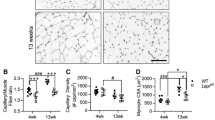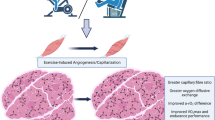Abstract
Angiogenesis is a tightly regulated process, both during development and adult life. Animal models with mutations in the genes coding for placental growth factor (PlGF), a member of vascular endothelial growth factor (VEGF) family, or the tyrosine kinase domain of the PlGF receptor (Flt-1) have revealed differences between normal physiological angiogenesis and pathological angiogenesis associated with conditions such as tumor growth, arthritis and atherosclerosis. In the present paper, we investigated the potential role of PlGF in regulating physiological angiogenesis by analyzing vascular changes in heart and skeletal muscles of wild-type and Plgf−/− mice following prolonged and sustained physical training. Sedentary Plgf−/− mice showed a reduced capillary density in both heart and skeletal muscles as compared to wild-type mice (P < 0.05). However, after a 6-week training period, heart/body weight ratio, citrate synthase activity, vessel density and capillary/myocyte ratio were significantly increased in both wild-type and Plgf−/− mice (all P < 0.05). At the same time intercapillary distance was significantly reduced. Finally, acute exercise was not associated with any change in PlGF protein level in the skeletal muscle. Our results demonstrate that PlGF is not necessary for exercise-training-induced angiogenesis. We thus suggest that the role of PlGF is confined to the selective regulation of angiogenesis only under pathological conditions.
Similar content being viewed by others
Abbreviations
- CS:
-
citrate synthase
- EDTA:
-
ethylene di-amino tetra-acetic acid
- NAD:
-
nicotinamide adenine dinucleotide
- PlGF:
-
placental growth factor
- VEGF:
-
vascular endothelial growth factor
References
K Moulton J Folkman (1999) Angiogenesis and cardiovascular disease K Chien (Eds) Molecular Basis of Cardiovascular Diseases WB Saunders Philadelphia 393–410
P Carmeliet RK Jain (2000) ArticleTitleAngiogenesis in cancer and other diseases Nature 407 249–257
M Hedman J Hartikainen M Syvänne et al. (2003) ArticleTitleSafety and feasibility of catheter-based local intracoronary vascular endothelial growth factor gene transfer in the prevention of postangioplasty and in-stent restenosis and in the treatment of chronic myocardial ischemia: phase II results of the Kuopio Angiogenesis Trial (KAT) Circulation 107 2677–83
S Rajagopalan ER Mohler SuffixIII RJ Lederman et al. (2003) ArticleTitleRegional angiogenesis with vascular endothelial growth factor in peripheral arterial disease: a phase II randomized, double-blind, controlled study of adenoviral delivery of vascular endothelial growth factor 121 in patients with disabling intermittent claudication Circulation 108 1933–38
N Ferrara K Carver-Moore H Chen et al. (1996) ArticleTitleHeterozygous embryonic lethality induced by targeted inactivation of the VEGF gene Nature 380 439–42
P Carmeliet V Ferreira G Breier et al. (1996) ArticleTitleAbnormal blood vessel development and lethality in embryos lacking a single VEGF allele Nature 380 435–39
EC Breen EC Johnson H Wagner et al. (1996) ArticleTitleAngiogenic growth factor mRNA responses in muscle to a single bout of exercise J Appl Physiol 81 355–61
Y Chen RJ Torry GL Baumbach et al. (1994) ArticleTitleProportional arteriolar growth accompanies cardiac hypertrophy induced by volume overload Am J Physiol 267 H2132–37
T Gustafsson A Puntschart L Kaijser et al. (1999) ArticleTitleExercise-induced expression of angiogenesis-related transcription and growth factors in human skeletal muscle Am J Physiol 276 H679–85
T Gustafsson W Kraus (2001) ArticleTitleExercise-induced angiogenesis related growth and transcription factors in skeletal muscle, and their modification in muscle pathology Front Biosci 6 D75–D89
TP Gavin CB Robinson RC Yeager et al. (2004) ArticleTitleAngiogenic growth factor response to acute systemic exercise in human skeletal muscle J Appl Physiol 96 19–24
FC White CM Bloor MD McKirnan et al. (1998) ArticleTitleExercise training in swine promotes growth of arteriolar bed and capillary angiogenesis in heart J Appl Physiol 85 1160–68
P Carmeliet L Moons A Luttun et al. (2001) ArticleTitleSynergism between vascular endothelial growth factor and placental growth factor contributes to angiogenesis and plasma extravasation in pathological conditions Nat Med 7 575–83
A Luttun M Tjwa L Moons et al. (2002) ArticleTitleRevascularization of ischemic tissue by Plgf treatment, and inhibition of tumor angiogenesis, arthritis and atherosclerosis by anti-Flt-1 Nat Med 8 831–40
M Autiero J Waltenberger D Communi et al. (2003) ArticleTitleRole of Plgf in the intra- and intermolecular cross-talk between the VEGF receptors in Flt1 and Flk1 Nat Med 9 936–43
C Nakao T Ookawara T Kizaki et al. (2000) ArticleTitleEffects of swimming training on three superoxide dismutase isoenzymes in mouse tissues J Appl Physiol 88 649–54
A Bass D Brdicza P Eyer et al. (1969) ArticleTitleMetabolic differentiation of distinct muscle types at the level of enzymatic organization European J Biochem 10 198–206
Errico M, Riccioni T, Iyer S et al. Identification of placental growth factor determinants for binding and activation of Flt-1 receptor. JBC 2004 [published July 21, 2004 as doi:10.1074/jbc.M401418200].
BM Pluim AH Zwindermann AE Laarse Particlevan der et al. (2000) ArticleTitleThe athlete’s heart A meta analysis of cardiac structure and function. Circulation 101 336–44
IM Olfert EC Breen O Mathieu-Costello et al. (2001) ArticleTitleSkeletal muscle capillarity and angiogenic mRNA levels after exercise training in normoxia and chronic hypoxia J Appl Physiol 91 1176–84
RS Richardson H Wagner SR Mudaliar et al. (1999) ArticleTitleHuman VEGF gene expression in skeletal muscle: effect of acute normoxic and hypoxic exercise Am J Physiol 277 H2247–H52
B Fernandez A Buehler S Wolfram et al. (2000) ArticleTitleTransgenic myocardial overexpression of fibroblast growth factor-1 increases coronary artery density and branching Circ Res 87 207–13
JR McMullen T Shioi L Zhang et al. (2003) ArticleTitlePhosphoinositide 3-kinase (p110alpha) plays a critical role for the induction of physiological, but not pathological, cardiac hypertrophy Proc Natl Acad Sci USA 100 12355–60
Author information
Authors and Affiliations
Corresponding author
Rights and permissions
About this article
Cite this article
Gigante, B., Tarsitano, M., Cimini, V. et al. Placenta growth factor is not required for exercise-induced angiogenesis. Angiogenesis 7, 277–284 (2004). https://doi.org/10.1007/s10456-004-4179-1
Received:
Accepted:
Issue Date:
DOI: https://doi.org/10.1007/s10456-004-4179-1




